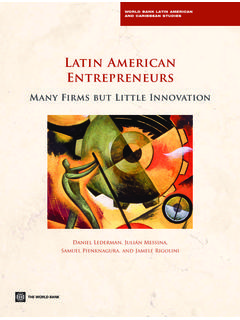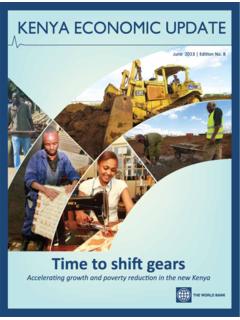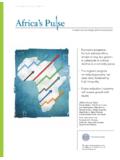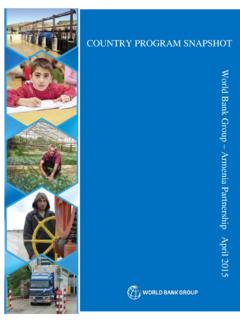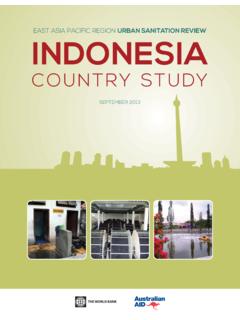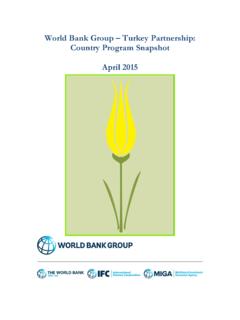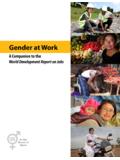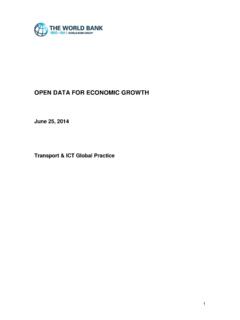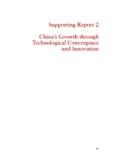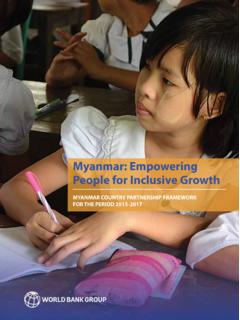Transcription of MYANMAR NOVEMBER, 2014 Ending poverty ... - …
1 Report No. 93050-MM. MYANMAR . november , 2 0 1 4. Ending poverty and boosting shared prosperity in a time of transition A SYSTEMATIC COUNTRY DIAGNOSTIC. ACKNOWLEDGEMENTS. This report was prepared by a world bank Group team from the world bank IDA, and the International Finance Corporation (IFC). led by Khwima Nthara (Program Leader & Lead Economist) under the direct supervision of Mathew Verghis (Practice Manager, MFM). and Shubham Chaudhuri (Practice Manager, MFM & poverty ). Cath- erine Martin (Principal Strategy Officer) was the IFC's Task Manag- er. Overall guidance was provided by Ulrich Zachau (Country Direc- tor), Abdoulaye Seck (Country Manager), Kanthan Shankar (Former Country Manager), Sudhir Shetty (Regional Chief Economist), Betty Hoffman (Former Regional Chief Economist), Constantinee Chikosi (Portfolio and Operations Manager), Julia Fraser (Practice Manag- er), Jehan Arulpragasam (Practice Manager), Hoon Sahib Soh (Op- erations Adviser), Rocio Castro (VP Adviser), Antonella Bassani (Strategy and Operations Director), Antony Gaeta (Country Program Coordinator), Maria Ionata (Former Country Program Coordinator),- Vikram Kumar (IFC Resident Representative), and Simon Andrews (Senior Manager).
2 The report drew from thematic input notes prepared by a cross-sec- tion of bank staff as follows: (1) Economic Growth, Structure, and Transformation: Douglas Addison (Senior Economist); (2) poverty Diagnostics: Manohar Sharma (Senior poverty Specialist), Min Ye Paing Hein ( poverty Specialist), Valerie Kozel (Senior poverty Econ- omist), and Jae Kyun ( poverty Consultant); (3) State Capacity, Legiti- macy, and Trust: Shabih Mohib (Program Leader) and Nikolas Myint (Senior Social Development Specialist); (4) Conflict, Fragility, and Risks: Asbjorn Wee (Senior Operations Officer) and Nikolas Myint (Senior Social Developmeng Specialist); (5) Social Relations, Inclu- sion, and Exclusion: Andrea Woodhouse (Senior Social Development Specialist); (6) Health: Hnin Hnin Pyne (Senior Human Develop- ment Specialist); (7) Education: Lars Sondergaard (Program Lead- er); (8) Social Protection: Puja Datta (Senior Economist); (9) Gender: Pamonrat Tansanguanwong (Senior Social Development Specialist).
3 (10) Agriculture: Sergiy Zorya (Senior Economist) and Paavo Elister (Lead Rural Development Specialist); (11) Land: Steven Jaffe (Lead Rural Development Specialist) and Keith Bell (Senior Land Policy Specialist), (12) Energy: Dejan Ostojic (Lead Energy Specialist) and Rome Chavapricha (Senior Energy Specialist); (13) Environment and Natural Resource Management: Ruxandra Floroiu (Senior En- vironmental Engineer); (14) ICT: Tenzin Domar (Program Coordi- nator); (15) Public Financial Management: Shabih Mohib (Program Leader); (16) Natural Resource Revenue Management: Edith Bowles (Consultant) and Motern Larsen (Mining Specialist); (17) Water Re- source Management: Claudia Sadoff (Lead Economist); (18) Invest- ment Climate: Nataliya Mylenko (Senior Financial Sector Specialist);. (19) Financial Sector Development: James Seward (Lead Financial Sector Specialist).
4 There were also invaluable contributions in the preparation of the document from the following team members: May Thet Zin (Coun- try Economist), Robert Taliercio (Lead Economist), Willy McCourt (Senior Public Specialist); Joel Turkewitz (Lead Public Sector Spe- cialist), Zhentu Liu (Senior Procurement Specialist); Corey Pattison (Consultant), Charles Scheider (Senior Operations Officer), Manush Hristov (Senior Counsel), Jason Pellmar (Senior Investment Officer), Thitsar Thitsar (Operations Officer), Khin Thida Maw (Operations Officer), Matt Davies (IMF). The Peer Reviewers were Shantayanan Devarajan (Chief Economist). and Tara Vishwanath (Lead Economist). The team also benefited immeasurably from interactions with Ambar Narayana (Lead Econ- omist) and Trang Van Nguyen (Senior Economist) of the SCD Advi- sory Group and Ana Revenga, Senior Director for the poverty Global Practice.
5 Acknowledgements are also due to the following members of the bank 's communications team for coordinating consultations, transla- tion, and dissemination: Kyaw Soe Lynn, Shin Thandar, Anne Elicano, Carl Patrick, Paul Risley, Diana Ya-Wai Chung, and Meriem Gray. In carrying out the consultations, the bank team benefitted from the services of the following consultants: Shona Kirkwood, Paul Donow- itz, and Sai Yarzar Htun. The following are also acknowledged for their administrative and logistical support: Maung Maung Win, Aye Me Me Htun, Aye Marlar Win, Angkanee Luangpenthong; Tasanee Chokwatana, Cecile Wodon, Lynn Yeargin, Mildred Gonsalvez, Ka- tia Nemes, and Xuemei Guo. The team would also like to express its appreciation to the Govern- ment of the Republic of the Union of MYANMAR for its support and cooperation. Special thanks are due to the Minister of Finance, His Excellency U Win Shein, the Deputy Minister of Finance, His Excel- lency Lin Aung, the Director General, U Maung Maung Win and the Deputy Director General Daw Nwe Nwe Win.
6 The team is also grate- ful to Government Officials from various Regional and State Govern- ments where consultations were held, other Government officials at the Union level, Civil Society Organizations, academics, think tanks, representatives of the private sector and development partner institu- tions for their inputs during the consultations process. 2 | world bank Report ABBREVIATIONS AND ACRONYMS. ADB Asian Development bank MOHT Ministry of Hotels and Tourism AIDS Acquired Immunodeficiency Syndrome MNPED Ministry of National Planning and Economic ASEAN Association of Southeast Asian Nations Development ATM Automated Teller Machine MP Member of Parliament CBM Central bank of MYANMAR MPLCS MYANMAR poverty and Living Conditions Survey CEDAW Committee on the Elimination of Discrimination against MPT MYANMAR Posts and Telecommunications Women MSE Microfinance Supervisory Enterprise CESD Center for Economic and Social Development MSME Micro Small Medium Enterprise CESR Comprehensive Education Sector Review NGO Non-Governmental Organization CPF Country Partnership Framework NRC National Registration Card CSO Civil Society Organization NSDS National Strategy for the Development of Statistics DB Defined Benefit NTM Non-Tariff
7 Measures DFID Department for International Development OECD Organization for Economic Co-operation and DSA Debt Sustainability Analysis Development DTIS Diagnostic Trade Integration Study OOP Out-Of-Pocket DU Delivery Unit PEFA Public Expenditure and Financial Accountability EAP East Asia Pacific PER Public Expenditure Review EITI Extractive Industries Transparency Initiative PFM Public Financial Management EMIS Education Management Information System PPP Public-Private Partnership ESIA Environmental and Social Impact Assessment PSC Production Sharing Contract EU European Union QSEM Qualitative Social and Economic Monitoring FAB Farmland Administration Body SABER Systems Approach for Better Education Results FDI Foreign Direct Investment SCD Systematic Country Diagnostic FESR Framework for Economic and Social Reform SEE State Economic Enterprise FIL Financial Institutions Law SEZ Special Economic Zone GDP Gross Domestic Product SIDA Swedish International Development Agency HIV Human Immunodeficiency Virus SIM Social Impact Monitoring HRD Human Resource Development SLORC State Law and Order Restoration Council ICA Investment Climate Assessment SLRD Settlement and Land Records Department ICT Information and Communications Technology SME Small and Medium Enterprise IDP Internally Displaced People SMP Staff Monitored Program IFC International Finance Corporation SNA System of National Accounts IHLCA Integrated Household Living Conditions Assessment SOE State Owned Enterprise IHLCA-2 Integrated Household Living Conditions Assessment - 2 SP Social Protection ILO International Labor Organization STEPS Skills for Training, Employment.
8 Progression and IMF International Monetary Fund Self-development INGO International Non-Governmental Organizations SWG Sector Working Group IPP Independent Power Producer TSI Trade Support Institution IRD Internal Revenue Department TVET Technical and Vocational Education and Training JICA Japan International Cooperation Agency UMEHL Union of MYANMAR Economic Holdings Limited JMP Joint Monitoring Program UN United Nations KIO Kachin Independence Organization UNCTAD United Nations Conference on Trade and Development KNU Karen National Union UNDP United Nations Development Programme LSCI Liner Shipping Connectivity Index UNICEF United Nations Children's Fund LUC Land Use Certificate UNODC United Nations Office on Drugs and Crime MADB MYANMAR Agricultural Development bank USA United States of America MDRI MYANMAR Development Resource Institute USD United States Dollar MEB MYANMAR Economic bank USDA United States Department of Agriculture MEC MYANMAR Economic Cooperation USDP Union Solidarity and Development Party MFI Micro Finance Institution VFV Vacant, Fallow, and Virgin MIC MYANMAR Investment Commission WASH Water, Sanitization and Hygiene MICS Multiple Indicator Cluster Survey WB world bank MIGA Multilateral Investment Guarantee Agency WBG world bank Group MOE Ministry of Education WDR world Development Report MOF Ministry of Finance WHO world Health Organization MOH Ministry of Health WTO world Trade Organization 10 I.
9 Country context C. Economic growth, setting the stage 13 structure, and transformation D. Rationale for a Systematic Country Diagnostic 16. 10. A. The transformation of MYANMAR 's polity, economy, and society 17 E. Conceptual framework for the MYANMAR SCD. 6 B. Country's economic F. Sources of information, EXECUTIVE. SUMMARY. situation and historical context 11 consultations, and quality of data 17. 20 II. A profile of poverty in MYANMAR 21 25. D. Vulnerability to A. The incidence of poverty poverty and the extent of inequality 23 B. The spatial distribution of poverty E. A taxonomy of the poor and what it C. Characteristics of the poor and the correlates and causes of poverty 24. suggests about pathways out of 25. poverty 27 III. PATHWAYS OUT OF poverty and intervention areas 28 A. Strategic Framework for Inclusive and Sustainable Growth B.
10 The Government's reform program 28 51. 29 C. Critical next steps IV. KNOWLEDGE GAPS, IMPLICATIONS, AND. 1. Considerations in identifying priority PROPOSPED ANALYTICAL. intervention areas and sequencing 29 WORK AGENDA. 29 2. Identified areas of intervention 3. Rationale for interventions 30. 54 BIBLIOGRAPHY. 4 | world bank Report LIST OF BOXES. Box 1: MYANMAR 's Unique History and Circumstances 12. Box 2: What is an SCD? 16. Box 3: Overview of key data issues in MYANMAR 17. Box 4: The MYANMAR SCD consultations process 19. Box 5: Comparing MYANMAR 's rice yield data with other countries in the region 45. LIST OF FIGURES. Figure 1: MYANMAR real GDP growth rate, 2005/06-2013/14 13. Figure 2: Growth rates for comparator countries, 2012/13 13. Figure 3: Recorded export value and composition 14. Figure 4: Level and composition of exports 14.
